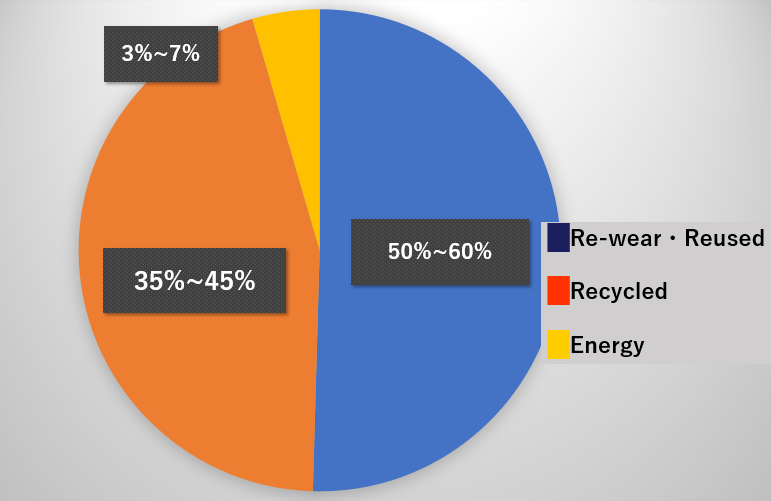H&М Co
Nowadays, many companies are pursuing sustainability and taking various measures to reduce clothing loss.
In the midst of all this, I had the opportunity to interview H&M, which is one of the first companies to take steps to reduce clothing loss.
Why did you decide to take a sustainable approach?
H&M's business concept is to provide fashion and quality at the best possible price in a sustainable manner.
For us, as a fashion company, sustainability means "the ability to enjoy fashion for a long time to come." In order to realize this concept, we are working every day to provide economically viable products to all people while taking the environment and society into consideration.
What percentage of the collected clothes are reused or recycled?
And if you cannot re-wear, reuse, or recycle the garments, what do you do with them?
All clothes collected from customers are handed over to I:CO, a company with which we have a business partnership, and are sorted into three categories according to more than 400 criteria: Re-wear (sold as used clothes), Reuse (industrial cleaning cloths, remake materials, etc.), and Recycle (raw materials for new textile products, damping materials for automobiles, cushioning materials, etc.). Items that cannot be categorized as such for health and safety reasons are reused as fuel for energy recovery.
In terms of the breakdown, 50%-60% of the clothes collected at H&M stores are reused, 35%-45% are recycled, and 3-7% are used for energy.
The above percentages may vary due to changes in the clothing and textiles collected at different times of the year.

Is there anything in the process of making your products that has a negative impact on the environment?
All products, including fashion, are inevitably impacted by the environment, from the procurement of raw materials to production, use of the product, and final disposal.
In our latest sustainability report, we have included a diagram showing the impact of each step in the value chain.
Please refer to page 10 of the H&M Group Sustainability Performance Report.
For example, in order to address the issue of water consumption in cotton cultivation, we have partnered with WWF, an environmental conservation organization, to create a roadmap for water resources, water management, and initiatives at supplier factories.
What specific measures are you taking to reduce the number of unsold products in fast fashion?
The problem generally referred to as fashion loss due to overproduction, etc., is an issue facing the entire fashion industry.
The H&M Group makes appropriate sales as much as possible through buying according to demand and seasonal campaigns.
Since 2018, an AI department has also been established to continue to improve the company's ability to more accurately balance supply and demand, allocate goods to the right places, and deliver them.
We also encourage our customers to extend the life of their purchases and enjoy them for as long as possible, and to reuse, rather than discard, clothing that is no longer needed.
How do you handle unsold products from a sustainable perspective?
As mentioned in the previous question, we are taking various measures to reduce excess inventory as much as possible, but if we still have excess inventory that can be sold, used, or recycled, we will not send it to a landfill or incinerate it unless it is a health and safety issue.
In the case of unsold items, we carry them over to the next season or sell them through our group's off-price brand and secondary distribution platform.
In order for customers to be able to enjoy fashion for a long time, we are also making efforts to make sustainability information available on our website so that many customers will be aware of it.
While your company is working on sustainable initiatives, is there anything you would like us, the consumers, to do?

We encourage consumers to choose materials that are made with consideration for the environment and society at the time of purchase as much as possible, to take care of their clothes after purchase and wear them for as long as possible, and to reuse clothes that are no longer needed rather than discard them.
In order to promote these activities, we have developed the following measures that customers can participate in.
1.Used Clothing Collection Service(Collect unwanted clothing, regardless of brand or condition, in exchange for a 500 yen off coupon per bag)
2.green tag(The tag is attached to products that are made from at least 50% recycled or sustainably sourced materials. The name of the material and its breakdown are listed for easy reference. On-line, it is marked CONSCIOUS.)
3.In the "Product Sustainability Information" tab of the product pages on the online site, you can find information on the sustainability of each product.Information on materials, country of production, and production plant.
4.Use your own bags/refuse to buy shopping bags(In order to reduce the consumption of shopping bags, a fee of 20 yen per bag will be charged.)
In addition, we have also set up a sustainability page on our official website in order to help our customers better understand sustainability.
We also have a special website on sustainability for our Japanese customers.
We hope that this will encourage as many customers as possible to think about the actions they can take in their daily lives through fashion.
We would like to know if there are any new issues or problems that have emerged in the course of promoting sustainable initiatives, or if there are any new initiatives that you are planning to undertake in the future.
We are working on various initiatives to achieve our goal of switching all of our materials to recycled or sustainably sourced materials by 2030 andbecoming a climate-positive company throughout the value chain by 2040.
By 2020, we will have switched all of our cotton use to recycled or sustainable materials,and 64.5% of all materials we use today are recycled or sustainably sourced.
Our goal is to achieve a switchover of at least 70%by 2021.
Although there are still some issues to be addressed, such as the limitations of recycling technology, we will continue to support technological development and the use of innovative materials in our various efforts to deliver sustainable and fashionable collections.
Thank you very much to H&M for taking time out of their busy schedule for this interview.

















